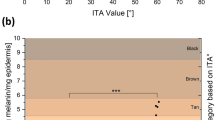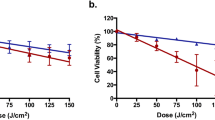Summary
To determine whether a tan produced by 8-MOP and UVA protects from subsequent solar light irradiation, volunteers were irradiated with unfiltered Xenon arc light before and 10 days after a 1 week's course of four 8-MOP-UVA treatments. Evaluation of the minimal erythema doses and of histological changes before and after 8-MOP-UVA treatment revealed that the 8-MOP-UVA induced tan protected against the erythemogenic and cell damaging effects of Xenon arc light. Unscheduled repair DNA synthesis, used as a measure for UVB-induced DNA damage and repair, was also investigated in skin irradiated with the Xenon arc before and after 8-MOP-UVA induced tanning. Both the number of grains per sparse labeled cell and the number of sparse labeled cells per 1000 cells, were found to be significantly lower in tanned skin; taking decreased unscheduled repair DNA synthesis as a measure for decreased DNA-damage, these findings also demonstrate a photoprotective effect of the 8-MOP-UVA induced tan.
Zusammenfassung
Zur Klärung der Frage, ob die durch 8-Methoxypsoralen (8-MOP) und langwelliges Ultraviolett-Licht (UV-A) induzierte Hautbräunung vor Sonnenbestrahlung schützt, wurden Testpersonen mit einer ungefilterten Xenon-Lampe vor und 10 Tage nach einer einwöchigen 8-MOP/UV-A-Behandlung (4 Expositionen) bestrahlt. Die Beurteilung erfolgte klinisch durch die Bestimmung minimaler Erythemdosen, cytomorphologisch durch Beurteilung UV-inducierter Gewebs- und Zellschäden in bioptischem Material und autoradiographisch durch die »unscheduled repair«-DNS-Synthese. Ein Vergleich der cutanen Reaktion auf eine definierte, von der Xenon-UV-Quelle (sonnenähnliches Spektrum) emittierten Energiedosis vor und nach Hautpigmentierung durch 8-MOP-UVA zeigte 1) klinisch eine signifikante Anhebung der minimalen Erythemschwelle, 2) histologisch eine signifikante Abnahme UV-inducierter Zellschäden und 3) autoradiographisch eine deutliche Abnahme von Repair-Aktivität als Maß eingetretener DNS-Schädigung. Sowohl die Zahl der Zellen mit Repair-Aktivität, als auch die Summe von Silberkörnern in markierten Zellen waren signifikant erniedrigt. Da die »unscheduled repair«-DNS-Synthese ein Maß für UVB induzierte DNS-Schäden und Reparaturvorgänge darstellt, wird auch anhand dieses Parameters ein Lichtschutzeffekt durch 8-MOP-UVA-Bräunung dokumentiert.
Similar content being viewed by others
References
Cleaver, J. E.: DNA damage and repair in light sensitive human skin disease. J. Invest. Dermatol. 54, 181–195 (1970)
Cripps, D. J., Ramsay, C. A., Carter, J., Boutwell, R.: Effect of monochromatic UV radiation on DNA synthesis with in vivo and in vitro autoradiography. J. Invest. Dermatol. 58, 312–314 (1972)
Daniels, F., Hopkins, C. E., Fitzpatrick, T. B.: Effects of oral methoxsalen on sunburn and suntan. Arch. Dermatol. (Chicago) 77, 503–507 (1958)
Daniels, F. Jr., Hopkins, C. E., Imbrie, J. D., Bergeron, L., Miller, O., Crowe, F., Fitzpatrick, T. B.: Field trials of the suntan promoting effects of methoxsalen. J. Invest. Dermatol. 32, 321–329 (1959)
Daniels, F. Jr., Imbrie, J. D.: Comparison between visual grading and reflectance measurements of erythema produced by sunlight. J. Invest. Dermatol. 30, 295–304 (1958)
Elliot, J. A.: Clinical experience with methoxsalen in suntanning. J. Invest. Dermatol. 32, 339–340 (1959)
Gschnait, F., Hönigsmann, H., Brenner, W., Fritsch, P., Wolff, K.: Induction of UV light tolerance by PUVA in patients with polymorphous light eruption. Br. J. Dermatol. (in press)
Epstein, J. H., Fukuyama, K., Epstein, W.: UVL induced stimulation of DNA synthesis in hairless mouse epidermis. J. Invest. Dermatol. 51, 445–453 (1968)
Fitzpatrick, T. B., Parrish, J. A., Pathak, M. A., Tanenbaum, L.: The risks and benefits of oral PUVA photochemotherapy of psoriasis. In: Psoriasis, Proceedings of the second international symposium, E. M. Farber, E. J. Cox (ed.), p. 320–327, 1976
Hopkins, C. E., Belisario, J. C., MacDonald, E. J.: Psoralen prophylaxis against skin cancer: report of a clinical trial II. J. Invest. Dermatol. 41, 219–223 (1963)
Imbrie, J. D., Daniels, F. Jr., Bergeron, L., Hopkins, C. E., Fitzpatrick, T. B.: Increased erythema threshold six weeks after a single exposure to sunlight plus oral methoxsalen. J. Invest. Dermatol. 32, 331–338 (1959)
Johnson, B. E., Mandell, G., Daniels, F.: Melanin and cellular reactions to ultraviolet radiation. Nature New Biol. 235, 147–149 (1972)
Kaidbey, K. H., Kligman, A. M.: Sunburn protection by longwave ultraviolet radiation-induced pigmentation. Arch. Dermatol. 114, 46–48 (1978)
Kanof, N. B.: Clinical experiences with the effect of oral 8-methoxypsoralen on the pigmentary responses of the skin to sunlight. J. Invest. Dermatol. 32, 343–344 (1959)
Miescher, G.: Das Problem des Lichtschutzes und der Lichtgewöhnung. Strahlentherapie 35, 403–443 (1930)
Parrish, J. A., Fitzpatrick, T. B., Tanenbaum, L., Pathak, M. A.: Photochemotherapy of psoriasis with oral methoxypsoralen and long-wave ultraviolet light. N. Engl. J. Med. 291, 1207–1211 (1974)
Pathak, M. A., Fitzpatrick, T. B.: The role of natural photoprotective agents in human skin. In: Sunlight and Man. M. A. Pathak, L. C. Harber, M. Seiji, A. Kukita (ed.), p. 725–750. The University of Tokyo press 1974
Rodighiero, G., Dall'Acqua, F.: Biochemical and medical aspects of psoralens. J. Photochem. Photobiol. 24, 647–653 (1976)
Stegmaier, O. C.: The use of methoxsalen in sun tanning. J. Invest. Dermatol. 32, 345–349 (1959)
Van der Leun, J. C.: Light induced tolerance to light in photodermatoses. Br. Photobiol. Soc. Meet., 23rd October (1974)
Van der Leun, J. C., Davidse, J.: What is just perceptible erythema? In: Progress in Photobiology, Proceedings of the VI. International Congress on Photobiology, G. O. Schenck (ed.), p. 47, 1976
Willis, I., Kligman, A., Epstein, J.: Effects of long ultraviolet rays on human skin: photoprotective of photoaugmentative. J. Invest. Dermatol. 59, 416–420 (1973)
Wolff, K., Gschnait, F., Hönigsmann, H., Konrad, K., Parrish, J. A., Fitzpatrick, T. B.: Phototesting and dosimetry for photochemotherapy. Br. J. Dermatol. 96, 1–10 (1977)
Wolff, K., Fitzpatrick, T. B., Parrish, J. A., Gschnait, F., Gilchrest, B., Hönigsmann, H., Pathak, M. A., Tanenbaum, L.: Photochemotherapy for psoriasis with orally administered methoxsalen. Arch. Dermatol. 112, 943–950 (1976)
Author information
Authors and Affiliations
Rights and permissions
About this article
Cite this article
Gschnait, F., Brenner, W. & Wolff, K. Photoprotective effect of a psoralen-UVA-induced tan. Arch Dermatol Res 263, 181–188 (1978). https://doi.org/10.1007/BF00446439
Received:
Issue Date:
DOI: https://doi.org/10.1007/BF00446439




